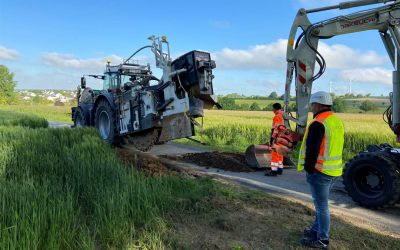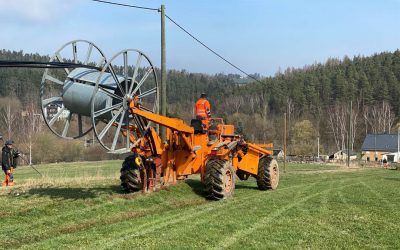When implementing broadband projects, different methods are used to lay the fibre optic cables. In contrast to “classic” civil engineering, in which an open trench is dug and the pipes are laid at least one meter deep, alternative laying techniques require less depth – and ideally almost no large excavation pit(s). Modern methods also save time and, not least, money.
In the third part of our “Alternative installation methods” series, we show you the option of laying fibre optic cables above ground. As a rule, cables are laid underground. However, in some particularly rural regions, this is not done for cost reasons. In this case, above-ground laying is used. Existing wooden poles are usually used for this.
Most people in Germany are probably most familiar with wooden pylons from rural areas, where they still often supply small villages or remote settlements with electricity. For some years now, these existing supply lines in particular have also become interesting for the expansion of future-proof fibre optic connections: According to figures from the Scientific Institute for Infrastructure and Communication Services (WIK), 80 to 90 percent of the costs of fibre optic expansion are attributable to the use of personnel, materials and machinery in civil engineering. So it makes sense to hang the fibre optic cables on the existing masts – which are not necessarily made of wood, of course, but can also be made of concrete or steel – and thus save time and money during installation.
The head of the Federal Chancellery, Helge Braun, is also in favor of laying fibre optic cables above ground in order to achieve the German government’s gigabit target as quickly as possible. “I am totally open to above-ground cabling,” Braun emphasised in September 2019 – even if this is not a solution for “all eternity”. You only have to go to Italy to see that “even on the historic cathedral in the old town, everything above ground is connected with cables”. Nevertheless, the quality of life in Italy is “extraordinarily high”.
The Federal Ministry of Transport and Digital Infrastructure (BMVI) also sees above-ground laying as an option “for supplying smaller towns and districts or properties located outside a town” and also as an option “for efficiently bridging longer distances”.

Photo: District of Emsland
In addition, the legal situation is rather unproblematic: the extension of existing above-ground telecommunications lines (replacing a cable or attaching a new cable to an existing wooden mast) does not, in the view of the BMVI, generally constitute a change requiring approval within the meaning of the Telecommunications Act (TKG).
Naturally, however, installing fibre optic cables on wooden poles also has disadvantages that should not be underestimated: poles and cables are subject to the permanent influence of the weather and are particularly vulnerable in the event of storms or ice breakage, for example. In addition, there are dangers such as vandalism or damage caused by birds or other animals that can damage the lines. Last but not least, wooden poles have a limited service life and must also be regularly maintained during this cycle.
Nevertheless, the use of wooden masts – albeit temporarily – can be a sensible solution for achieving the German government’s broadband targets in order to provide citizens and companies with future-proof gigabit connections as quickly as possible.
Such usage scenarios already exist in practice: For example, the Nümbrecht municipal utility company – which also supplies electricity to the very rural community in the Bergisches Land region of North Rhine-Westphalia, which has been awarded the status of a climatic health resort – has been able to use its existing power lines with wooden pylons profitably in the expansion of fibre optics, which is supported by the federal broadband funding programme, among other things.

Photo: Gemeindewerke Nümbrecht
In this way, a total of 39 kilometers of fibre optic cables were laid over existing electricity pylons in the municipal area (a good 17,000 inhabitants in an area of just under 72 square kilometers). Around half of this distance is accounted for by the individual overhead lines in the so-called low-voltage local network up to the individual houses and the other half by the “large routes” – the so-called medium-voltage routes – between the towns.
Wooden masts are also being used for laying the federally funded fibre optic expansion in the district of Emsland, where almost 119 kilometers of fibre optic lines have been installed by the expanding network operator Deutsche Telekom. These are not only routes to the “last milk can”, but also entire streets with numerous agricultural businesses that are being connected with future-proof fibre optic connections.

Photo: Landkreis Emsland
Telekom uses so-called mast boxes on the wooden masts to connect the respective buildings. The fibre optic cables branching off from the mast and fitted with a plug are simply plugged into these grey, square and waterproof boxes (“plug & play”). The fibre optic cable is then routed from the mast box to the corresponding house connection.

Photo: Landkreis Emsland
In its own blog, the Magenta Group sees above-ground fibre optic installation as “an excellent solution for connecting somewhat remote yards”. And the responsible Telekom employee Mario Zerson announced back in September 2018: “I assume that with our current three million wooden poles, we have some where we will attach this system.”
Our “Alternative installation methods” series
DIN 18220 comes into effect – Alternative installation methods standardized
DIN 18220 comes into force on July 28. The full name of the standard is "DIN 18220:2023-08. Trenching, milling and ploughing methods for laying empty conduit infrastructures and fiber optic cables for telecommunications networks" and describes in detail the methods...
Classic and alternative installation methods
In order to enable the expansion of fiber optic networks throughout Germany, the players involved have a variety of installation methods at their disposal. The methods must be selected according to topological characteristics and special project requirements. Each...
Robots lay fiber optics in the sewer
An employee prepares the robot for use. Between 100 and 250 meters of fibre optic cable can be laid in this way per day. (Source: Fast Opti-com) Laying fiber optic cables in sewage pipes using robots is one of the alternative installation methods. These offer many...
DIN 18220 comes into effect – Alternative installation methods standardized
DIN 18220 comes into force on July 28. The full name of the standard is "DIN 18220:2023-08. Trenching, milling and ploughing methods for laying empty conduit infrastructures and fiber optic cables for telecommunications networks" and describes in detail the methods...
Classic and alternative installation methods
In order to enable the expansion of fiber optic networks throughout Germany, the players involved have a variety of installation methods at their disposal. The methods must be selected according to topological characteristics and special project requirements. Each...
Robots lay fiber optics in the sewer
An employee prepares the robot for use. Between 100 and 250 meters of fibre optic cable can be laid in this way per day. (Source: Fast Opti-com) Laying fiber optic cables in sewage pipes using robots is one of the alternative installation methods. These offer many...
Using traditional technology for a future-proof broadband connection: the plowing method as an alternative laying technique
The cable plow in use on a field. At the top left is the empty conduit, which is unwound from the drum and then laid in the freshly plowed furrow Photo: IBZ Neubauer When implementing broadband projects, different methods are used to lay the fiber optic cables. In...





